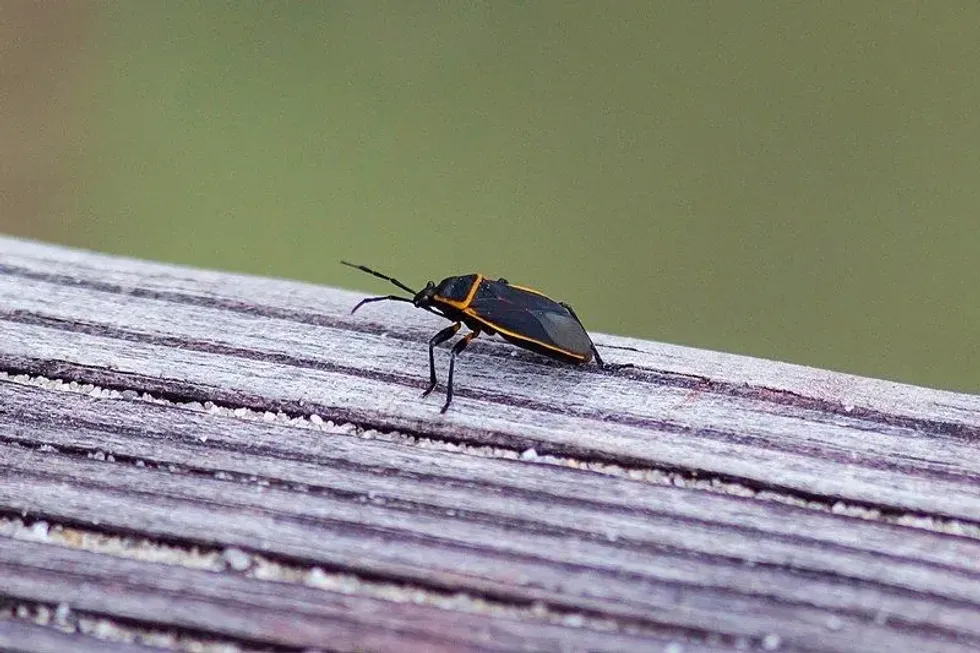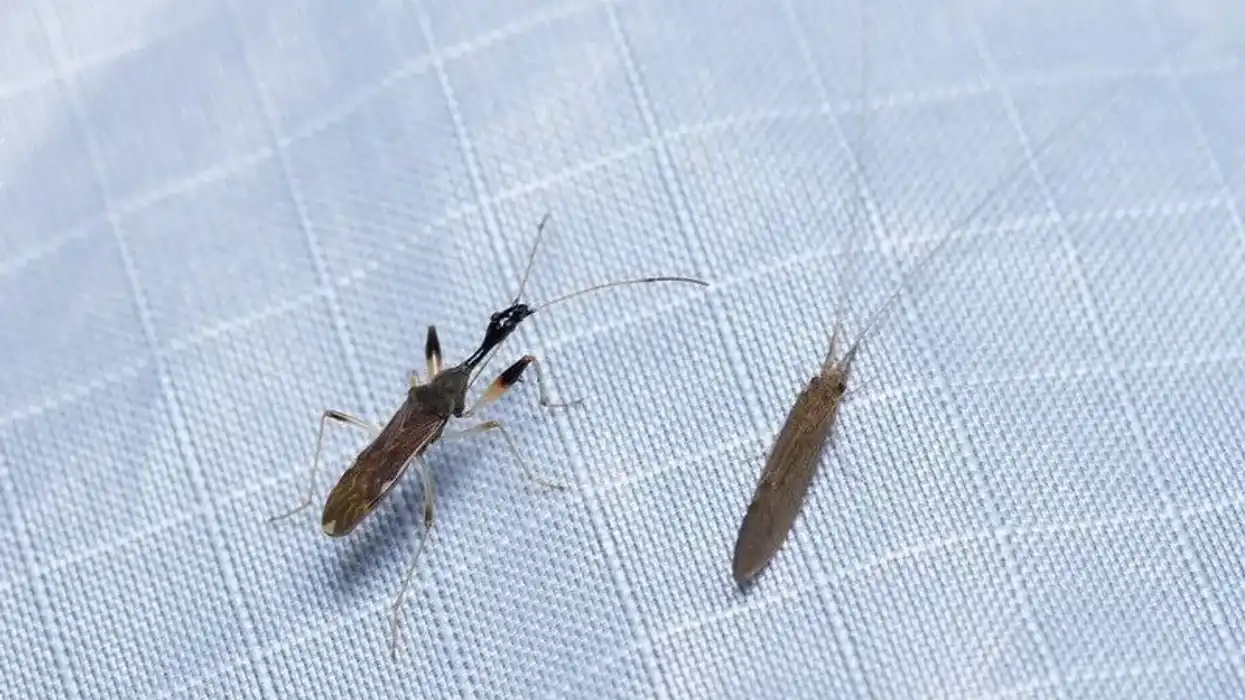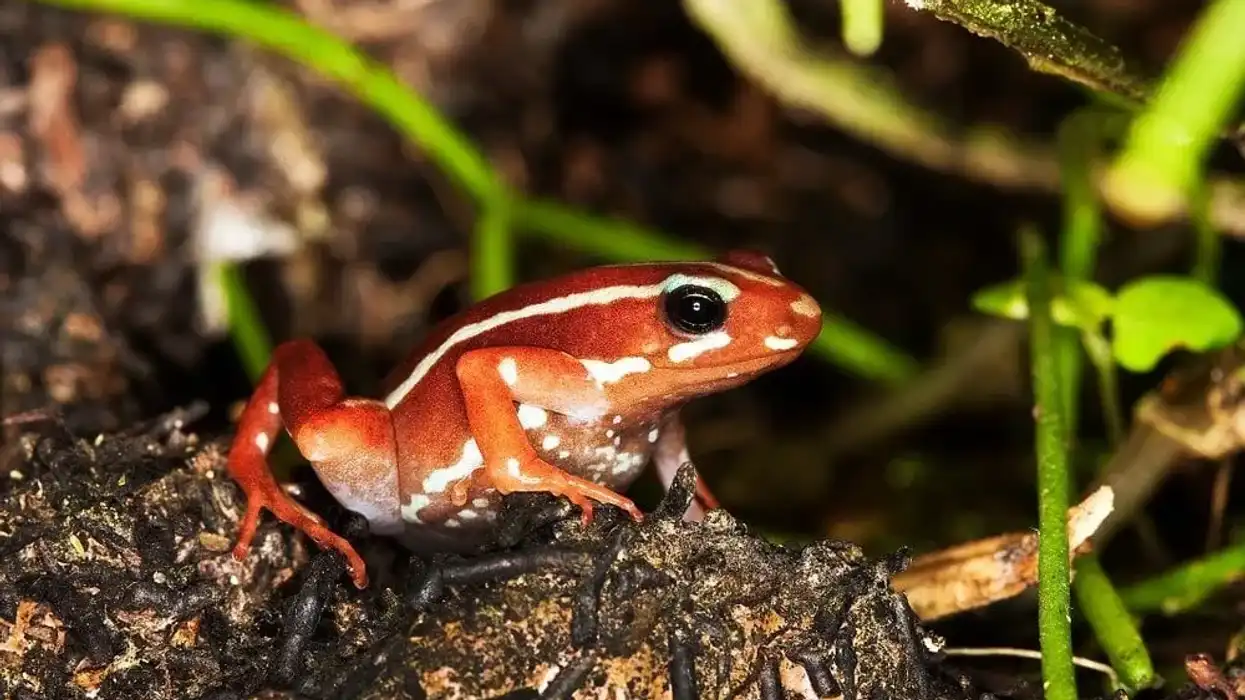A native insect to the Pacific Northwest and Southwest region of North America, the bordered plant bug (Largus succinctus) is known by several names such as largus bug and red bug. This species of the Largidae family possesses contrasting colored edges to its hemelytra or forewings. They are also known as true bugs.
The bordered plant bug possesses a black or grayish-blue body with either an orange or red band that divides the thorax and abdomen. Their orange wings have orange edges with black spots and their legs are black while their joints are orange.
The bordered plant bug (nymph) has a metallic blue body with a red dot in the center of its back.
Bordered plant bugs generally feed using their piercing-sucking mouthparts and they are found mainly on the ground. Their food mainly includes the liquid extracted from the tissues of plants and their feeding is primarily concentrated on fruit and flowers, the most nutritious parts of plants. In the garden, these true bugs generally attack strawberries, blueberries, and tomatoes.
The proliferation of these bugs is most common in the summertime as females generally lay eggs in the spring season and nymphs attain adulthood during the summer season. These bugs can be removed by using a shop vac or mason jar but chemical controls are not recommended.
For more relatable content, check out these Eastern Hercules beetle facts and wood tick facts for kids.
Bordered Plant Bug Interesting Facts
What type of animal is a bordered plant bug?
The bordered plant bug (Largus succinctus) is regarded as one of the most significant pests that possesses an orange or red band on its body. These bugs generally feed on food from the garden and their food mainly includes the liquid extracted from the tissues of plants. They are also known as true bugs.
What class of animal does a bordered plant bug belong to?
Bordered plant bugs belong to the class of Insecta, the family of Largidae, and the Largus genus. These bugs damage strawberries, blueberries, tomatoes, or anything else that is juicy in the garden!
How many bordered plant bugs are there in the world?
The exact population of bordered plant bugs is not known as of now but these insects usually appear in large numbers. The number is so significant that a common bordered plant bug swarm can become a nuisance easily and they must be handled by any master gardener.
Where does a bordered plant bug live?
These insects are native to the Pacific Northwest and Southwest region of North America. These bugs are quite common in several regions of the United States such as California, Texas, Utah, South Dakota, Central Sierra, and many more.
What is a bordered plant bug's habitat?
The typical bordered plant bug habitat generally includes trees, shrubs, and the garden. In the summer season, these insects hover around plants and flowers in large numbers. These insects are also sometimes found around the house. In the summer months of June and July, these insects become quite active.
Who do bordered plant bugs live with?
Very little information regarding the social behavior of these pests is available as of now but, like other pest species, these insects are generally social and prefer to live with other bordered plant bugs. You can find them around trees, plants, and flowers and adult bugs often meet during the breeding season.
Nymphs often form groups that consist of around 100 individuals and large congregations are found in regions such as California, Arizona, South Dakota, Central Sierra, and Vancouver.
How long does a bordered plant bug live?
Several species of bugs generally live for around three to four weeks, while a number of bugs live up to 54-60 weeks. The bordered plant bugs live for between two to seven months.
How do they reproduce?
Very little information regarding the reproduction pattern of the insect is available as of now but it is believed that this insect follows the same method as others. Adult females lay eggs in the spring season and their cluster of eggs is mainly found on the ground.
A study has revealed that around 130 clusters are laid on the ground in this season.
Generally, eggs hatch in about 14 days, and the nymphs (young bugs) become adults during the summer season in June and July. Nymphs go through five stages and the nymphal stage generally lasts for around 100 days.
What is their conservation status?
The International Union for Conservation of Nature has not evaluated the status of this insect yet but populations of these pests seem to be stable as of now. The insect can easily be spotted around the garden, plants, and houses in North America.
Bordered Plant Bug Fun Facts
What do bordered plant bugs look like?
This insect possesses a black or grayish-blue body with either an orange or red band that divides the thorax and abdomen. Its orange wings have orange edges with black spots, and its legs are black while its joints are orange.
Bordered plant bug nymphs have a metallic blue body with a red dot in the center of their back. Bordered plant bugs generally feed using their piercing-sucking mouthparts.
How cute are they?
These insects are more of a problem for humans rather than being seen as cute. Whilst you wouldn't want to see them feeding on strawberries in your garden, the metallic blue bodies of nymphs do seem to be quite attractive! This insect is generally regarded as a pest.
How do they communicate?
There is no information regarding the communication methods of bordered plant bugs available as of now but it is said that these bugs generally use similar methods as other insects while communicating. These insects use touch and sound to perceive their environment. Adults often come closer to each other in the breeding season.
How big is a bordered plant bug?
The average length of a bordered plant bug is around 0.51-0.66 in (13-17 mm). This pest is bigger than a number of bugs such as the ambush bug and the lace bug.
How fast can bordered plant bugs move?
The exact speed of bordered plant bugs is not known as of now but these insects appear to be opportunistic feeders who rely on flight to get to their food. They use their wings while feeding on fruits and plants.
A large group of bugs is sufficient enough to damage a garden within hours and it becomes very difficult to carry out effective bordered plant bug control when faced with a large swarm.
How much does a bordered plant bug weigh?
The exact weight of the red-bordered plant bug is not known as of now.
What are their male and female names of the species?
There are no specific names given to male and female bugs of this species. Both male and female bugs are known as bordered plant bugs, and male and female adults are either black or grayish blue.
What would you call a baby bordered plant bug?
The babies of bordered plant bugs are called nymphs, they have a metallic blue body with a red dot in the center of their back. Nymphs go through five stages and the nymphal stage generally lasts for around 100 days.
What do they eat?
This pest is generally a herbivore and they primarily feed on fruits, flowers, leaves, wood. These insects possess piercing-sucking mouthparts that help them to extract the liquid from plant tissues. They are often preyed upon by anteaters and common toads.
Are they harmful?
The proliferation of these bugs is most common in the summertime when they generally attack juicy fruits such as strawberries, blueberries, tomatoes, and many more. It is said that the attack of the adults can easily become out of control so they can easily damage a garden within a few hours.
They are not particularly dangerous but they can be very harmful to gardens in North America. These bugs can be removed by using a shop vac or a mason jar but chemical controls are not recommended.
Would they make a good pet?
No, they are not considered as good pets.
Did you know...
Many bugs help in pollination and keep the soil they live in healthy.
How did the bordered plant bug get its name?
The bordered plant bug possesses a black or greyish-blue body with either an orange or red band that divides the thorax and abdomen. Its orange wings have orange edges with black spots, and its legs are black while its joints are orange.
The orange border gives it its name and differentiates it from the boxelder bug and other bug species.
What's the difference between a bordered plant bug and a beetle?
The major difference between both is their eating habits. Bordered plant bugs generally extract the liquid of fruits while beetles feed on seeds and fungus.
Here at Kidadl, we have carefully created lots of interesting family-friendly animal facts for everyone to discover! Learn more about some other insects from our fungus beetle facts or elm seed bug facts pages.
You can even occupy yourself at home by coloring in one of our free printable Bordered plant bug coloring pages.









